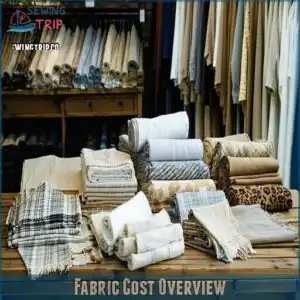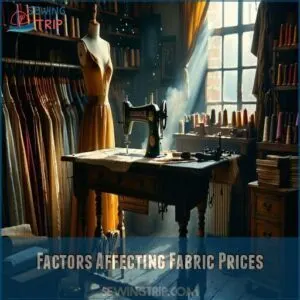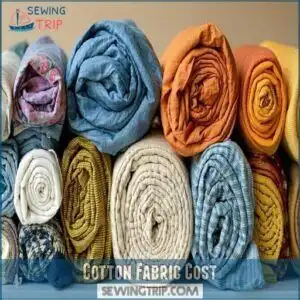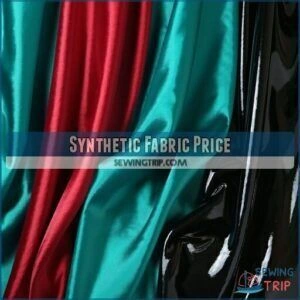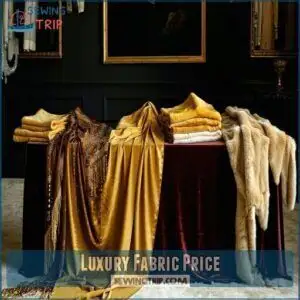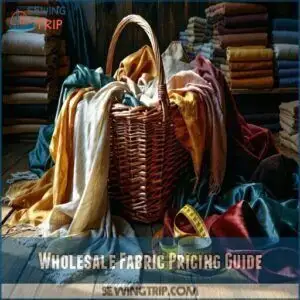This site is supported by our readers. We may earn a commission, at no cost to you, if you purchase through links.
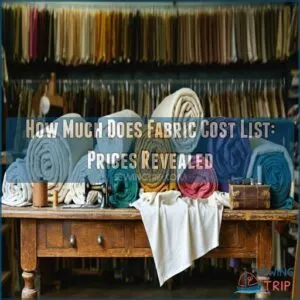 You’re looking for a fabric cost list, and you’ll find prices vary widely.
You’re looking for a fabric cost list, and you’ll find prices vary widely.
Natural fibers like cotton cost $5 to $25 per yard, while silk ranges from $20 to $25 per yard.
Synthetic fibers are often cheaper, and specialty fabrics like leather or suede can be pricey.
Your fabric cost will depend on the type, quality, and quantity you need, and it’s essential to make the most of your budget with the right fabric choices.
Check out the full breakdown to get a better sense of what you’ll pay for your next project.
Table Of Contents
Key Takeaways
- You’ll find that fabric costs vary widely, ranging from $5 to $50 per yard, depending on the type, quality, and quantity you’re looking to purchase.
- Natural fibers like cotton, silk, and wool tend to be pricier, with costs ranging from $5 to $110 per yard, while synthetic fabrics like polyester and nylon are more affordable options, costing between $3 to $10 per yard.
- The cost of fabric also depends on factors like material type, quality, manufacturing process, and market demand, so you’ll need to consider these when making your purchasing decisions.
- To get the best value for your money, you can calculate fabric costs by considering factors like type, quality, and quantity, and then apply discounts based on order volume, with prices varying from $5 to $3,000 per yard for bulk purchases.
Fabric Cost Overview
You’re about to discover the costs of various fabrics, from natural fibers like cotton and silk to synthetic and specialty fabrics.
As you explore the textile industry, you’ll find that prices vary widely, depending on factors like material type, quality, and manufacturing process.
Natural Fiber Costs
You’ll find natural fibers like cotton, with prices ranging from $5 to $25 per yard, and silk, costing $20 to $25 per yard, offer great quality and sustainability, impacting cotton fabric cost per yard and silk fabric price per yard, with organic costs affecting overall natural textiles.
Fabric pricing depends on several key determining factors, including fiber content and origin, which are key to understanding the natural textiles market.
Synthetic Fiber Costs
You’ll see synthetic fibers like polyester, nylon, and acetate are generally cheaper.
Here are some costs:
- Microfiber rates
- Elastane charges
- Acrylic fabric prices, with polyester fabric price per meter averaging lower than natural fibers, offering affordable options.
Specialty Fabric Costs
Beyond synthetics, specialty fabrics offer unique textures and durability.
Leather prices and suede materials range from $8 to $15 per square foot.
Denim expenses average $8 to $60 per yard.
Fur costs, both natural and faux, vary substantially.
Vinyl fabrics offer budget-friendly options.
| Fabric | Price Range (per yard/sq ft) |
|---|---|
| Leather | $8-$12/sq ft |
| Suede | $10-$15/sq ft |
| Faux Fur | $15-$20/yard |
Fabric Cost List
You’re creating a fabric cost list, considering fabric sourcing and textile trends.
Your list includes cotton, synthetic, and luxury fabrics, with prices varying by material and quality.
Reviewing the cost of fabrics, you compare fabric prices, noting color options and fabric care impact sewing costs, aiding your fabric cost comparison and decision-making.
Understanding fabric pricing factors is essential for budgeting and making informed decisions about fabric selection.
Factors Affecting Fabric Prices
You’re about to discover the key factors that affect fabric prices, which will help you make informed decisions when purchasing fabrics.
As you explore the realm of fabrics, you’ll find that material type, quality, manufacturing process, and market demand all play a significant role in determining the cost of fabrics.
Material Type
You’ll notice fabric cost varies greatly depending on material type, such as cotton, silk, or polyester fabric, affecting fabric density and textile weaving.
With fiber blends and yarn thickness impacting the final fabric cost per yard, as seen in the fabric price list, influencing material sourcing decisions, the final fabric cost is a crucial factor.
Quality and Durability
You consider fabric strength, material longevity, and textile resistance when evaluating quality and durability, which impact fabric cost and pricing, with wear testing and durability standards influencing the average cost of fabric, affecting your overall fabric price decision.
The cost of fabric is influenced by various factors, including fabric production costs, which can substantially impact the final price, considering aspects like material longevity and textile resistance.
Manufacturing Process
You’ll find that manufacturing process affects fabric cost, with spinning techniques, weaving methods, and dyeing process impacting textile engineering and fabric wholesale price, consequently influencing the cost of fabrics per yard.
Consumers are increasingly seeking sustainable sewing fabrics due to their eco-friendly properties, which is a key factor in the decision-making process for many buyers looking for sustainable options.
Market Demand
You see market demand impacting fabric prices.
- High demand
- Low supply
- Seasonal trends affect the average cost of fabric and wholesale fabric price, influencing your fabric price list and fabric prices comparison, considering supply chain and consumer behavior in demand forecast and price elasticity.
This situation is complex, involving many factors that influence the final cost, including seasonal trends and how they impact the market.
Fabric Type Price Comparison
You’re about to compare prices of different fabric types, which is essential in making informed purchasing decisions.
By examining the costs of cotton, synthetic, and luxury fabrics, you’ll gain a better understanding of what to expect when buying fabrics for your projects, which involves understanding complete concepts.
Cotton Fabric Cost
You’ll find cotton fabric cost varies.
| Cotton Type | Price |
|---|---|
| Quilting Solids | $9.92/yard |
| Blend Fabrics | $11.69/yard |
| Organic Cotton | $12-$15/yard |
For specific product options, explore this cotton fabric cost website.
Cotton prices depend on quality, brand, and yarn quality, affecting the average cost of cotton fabric.
Synthetic Fabric Price
Beyond cotton, synthetic fabrics offer budget-friendly choices.
Polyester costs and nylon prices are generally lower.
Acrylic fabrics and microfiber rates also contribute to this affordability.
You can compare current polyester fabric prices online.
| Fabric | Price Range (yard) | Polyester Cost per Metre (approx.) |
|---|---|---|
| Polyester Fabric | $3-25 | $3-27 |
| Nylon Fabric | $6-10 | $6-11 |
| Vinyl Fabric | $5-7 | $5-8 |
The prices of these fabrics, including polyester and nylon, vary based on the type and quality.
Understanding the price range is essential for making informed purchasing decisions.
Luxury Fabric Price
Luxury fabrics are exclusive and pricey due to their rare sources, intricate production, and superior performance.
A scarf made from Vicuña fabric, sourced from a South American camelid, starts from $4,000, while a jacket costs over $21,000.
Guanaco, another rare fabric, has fibers costing $400 per kilo.
Cashmere, a long-lasting luxury fabric, is challenging to source, with a premium sweater costing up to $2,400.
Understanding the fabric cost factors is essential for making informed purchasing decisions.
| Luxury Fabric | Price Range |
|---|---|
| Vicuña | $1,800 – $3,000+ per yard |
| Guanaco | $400 per kilo of fiber |
| Cashmere | Up to $2,400 for a premium sweater |
| Cervelt | $1,500 for a pair of socks |
| Mulberry Silk | Approximately $100 per yard |
The prices of these luxury fabrics vary significantly, with Vicuña being one of the most expensive options, and Mulberry Silk being relatively more affordable.
Wholesale Fabric Pricing Guide
You’re looking for a detailed guide to wholesale fabric pricing, and this section will provide you with the information you need.
By understanding wholesale vs retail pricing, cost calculation methods, and budget-friendly options, you’ll be able to make informed decisions when purchasing fabric in bulk.
This understanding will help you navigate the process of buying fabric more effectively, ensuring that you get the best value for your money.
Wholesale Vs Retail Pricing
So, you’re eyeing that gorgeous fabric, but the price tag makes you flinch? Consider the wholesale cloth market. Wholesale fabric prices often substantially undercut fabric prices at retail.
Understanding fabric pricing factors is essential for budgeting. Pricing models differ: retail includes fabric markup, while wholesale rates offer cost savings, especially with bulk discounts.
- Lower fabric wholesale prices.
- Potential bulk discounts.
- Reduced fabric markup.
- Increased cost savings.
Cost Calculation Methods
You calculate fabric costs using a fabric cost calculator, considering factors like weight and yarn cost.
| Fabric Type | Cost per Yard |
|---|---|
| Cotton | $5-$25 |
| Silk | $8-$110 |
| Linen | $10-$60 |
| Synthetic | $3-$25 |
The provided table outlines the cost per yard for different types of fabric, including Cotton, Silk, Linen, and Synthetic.
Budget Friendly Fabric Options
You can find budget-friendly fabric options with these 5 tips:
- Buy wholesale
- Shop online
- Use cheap textiles
- Compare fabric prices by the yard
- Look for discount fabric, achieving significant fabric savings on affordable materials for thrifty sewing, including cheap fabric online.
Considering cheap fabric online sources can help with cheap fabric shopping, which is a key aspect of thrifty sewing.
Seasonal Variations in Prices
You’ll notice seasonal variations in prices, with Winter Sales offering discounts on cozy fabrics and Summer Discounts on lightweight ones.
| Season | Fabric Trends | Prices |
|---|---|---|
| Winter | Cozy | High |
| Summer | Lightweight | Low |
| Spring | Pastel | Medium |
| Fall | Earthy | Medium |
The table provides a clear overview of the fabric trends and their corresponding prices for each season.
Frequently Asked Questions (FAQs)
What is the average price of fabric?
Fantastic fabric fans, you’ll find prices fluctuating, but generally, fabric costs range from $5 to $50 per yard, depending on the type, quality, and quantity you’re looking to purchase.
How much is 1 yard of fabric?
You’ll pay between $3 to $110 per yard, depending on the type of fabric, with natural fibers like silk and wool generally costing more than synthetic ones like polyester.
What is the fabric price?
What’s your budget for fabric? You’ll pay between $3 to $3,000 per yard, depending on the type, quality, and quantity of fabric you choose, with natural fibers tends to be pricier.
Which fabric is costly?
You’ll find Vicuña, Angora wool, and Dupioni silk are costly, with prices ranging from $1,800 to $300 per yard, due to their rare natural fibers and high-quality production processes.
How much does 1 yard of fabric cost?
You’ll find fabric prices vary, but generally, 1 yard costs between $5 to $110, depending on the type, quality, and brand of fabric you choose to purchase and work with.
How much is 10 yards of fabric?
You’ll pay between $50 to $250 for 10 yards of fabric, depending on the type, quality, and supplier, with natural fibers tend to be more expensive than synthetic ones.
How much does cotton fabric cost?
You’ll find cotton fabric costs between $5 to $25 per yard, depending on quality, with Pima cotton ranging from $8 to $12 per yard, and organic cotton around $12 to $
How much does a fabric set cost?
You’ll find fabric sets costing varying amounts, depending on type, quality, and quantity, with prices ranging from a few dollars to hundreds per yard, offering diverse options for projects.
How do you calculate fabric cost?
You calculate fabric cost by considering factors like type, quality, and quantity, then applying discounts based on order volume, with prices varying from $5 to $3,000 per yard.
How much does apparel fabric cost?
The cost of apparel fabric varies.
Natural fibers like cotton, linen, and silk are pricier, ranging from $5 to $60 per yard.
Synthetic fabrics are more affordable, with polyester and nylon ranging from $3 to $
Conclusion
Now you’ve got the inside scoop on fabric costs.
You’ll find the "how much does fabric cost list" varies, but with this guide, you’re ready to make informed decisions.
Remember, your fabric cost will depend on the type, quality, and quantity, so choose wisely and happy sewing with your new "how much does fabric cost list" knowledge.
- https://sino-silk.com/how-much-does-fabric-cost/
- https://fashinza.com/fabric/fabric-types/how-much-does-fabric-cost-ultimate-fabric-prices-list/
- https://craftanddesign.net/how-much-does-fabric-cost-/
- https://www.fashinza.com/?utm_source=blog&utm_medium=anchorlink
- https://www.leftyproductionco.com/post/6-factors-that-will-affect-your-garment-price

